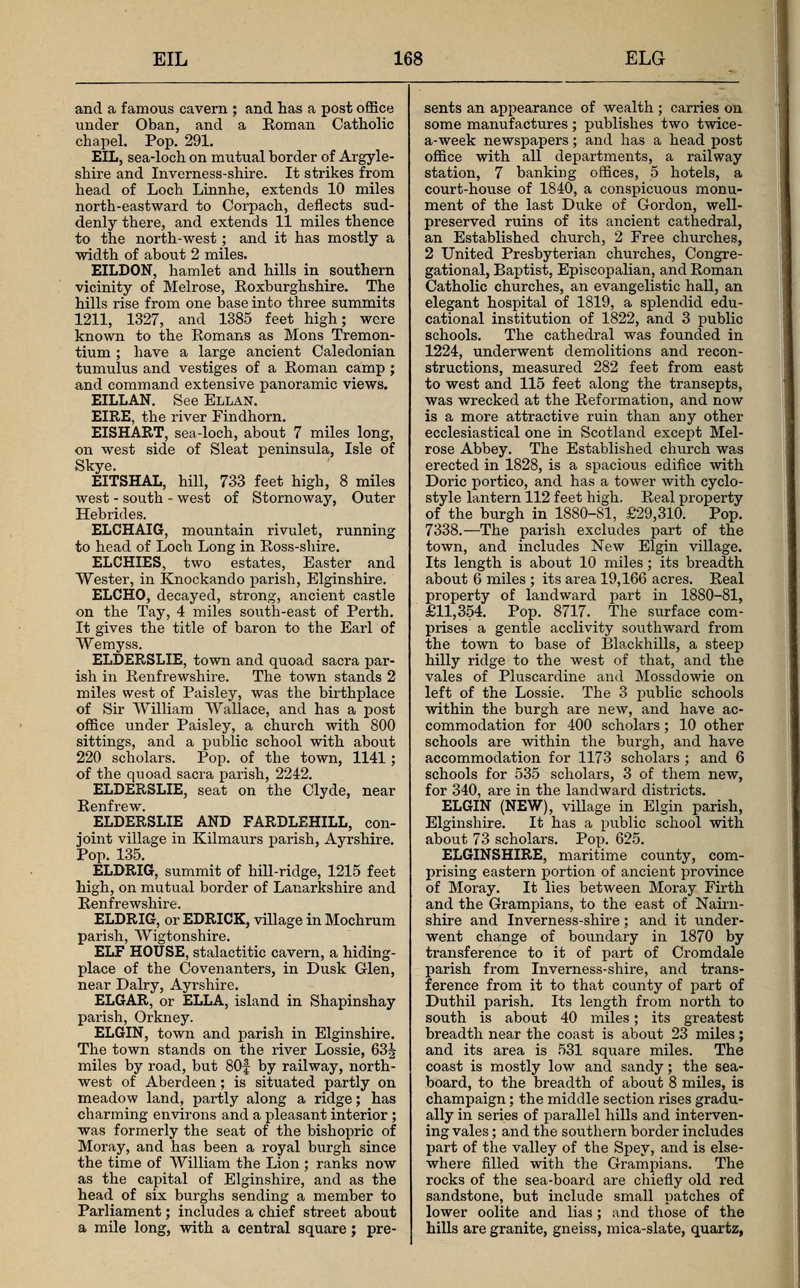EIL, sea-loch on mutual horder of Argyleshire and Inverness-shire. It strikes from head of Loch Linnhe, extends 10 miles north-eastward to Corpach, deflects suddenly there, and extends 11 miles thence to the north-west ; and it has mostly a width of about 2 miles.
EILDON, hamlet and hills in southern vicinity of Melrose, Roxburghshire. The hills rise from one base into three summits 1211, 1327, and 1385 feet high; were known to the Romans as Mons Trempn-tium ; have a large ancient Caledonian tumulus and vestiges of a Roman camp ; and command extensive panoramic views.
EILLAN.
EIRE, the river Findhorn.
EISHART, sea-loch, about 7 miles long, on west side of Sleat peninsula, Isle of
EITSHAL, hill, 733 feet high, 8 miles west-south-west of Stornoway, Outer Hebrides.
ELCHAIG, mountain rivulet, running to head of Loch Long in Ross-shire.
ELCHIES, two estates, Easter and Wester, in Knockando parish, Elginshire.
ELCHO, decayed, strong, ancient castle on the Tay, 4 miles south-east of Perth. It gives the title of baron to the Earl of Wemyss.
ELDERSLIE, town and quoad sacra parish in Renfrewshire. The town stands 2 miles west of Paisley, was the birthplace of Sir William Wallace, and has a post office under Paisley, a church with 800 sittings, and a public school with about 220 scholars. Pop. of the town, 1141; of the quoad sacra parish, 2242.
ELDERSLIE, seat on the Clyde, near Renfrew.
ELDERSLIE AND FARDLEHILL, con-joint village in Kilmaurs parish, Ayrshire. Pop. 135.
ELDRIG, summit of hill-ridge, 1215 feet high, on mutual border of Lanarkshire and Renfrewshire.
ELDRIG, village in Mochrum parish, Wigtonshire.
ELF HOUSE, stalactitic cavern, a hiding-place of the Covenanters, in Dusk Glen, near Dairy, Ayrshire.
ELGAR, island in Shapinshay parish, Orkney.
ELGIN, town and parish in Elginshire. The town stands on the river Lossie, 63i miles by road, but 80f by railway, north-west of Aberdeen; is situated partly on meadow land, partly along a ridge; has charming environs and a pleasant interior ; was formerly the seat of the bishopric of Moray, and has been a royal burgh since the time of William the Lion ; ranks now as the capital of Elginshire, and as the head of six burghs sending a member to Parliament ; includes a chief street about a mile long, with a central square ; presents an appearance of wealth ; carries on some manufactures ; publishes two twice-a-week newspapers ; and has a head post office with all departments, a railway station, 7 banking offices, 5 hotels, a court-house of 1840, a conspicuous monument of the last Duke of Gordon, well-preserved ruins of its ancient cathedral, an Established church, 2 Free churches, 2 United Presbyterian churches, Congregational, Baptist, Episcopalian, and Roman Catholic churches, an evangelistic hall, an elegant hospital of 1819, a splendid educational institution of 1822, and 3 public schools. The cathedral was founded in 1224, underwent demolitions and reconstructions, measured 282 feet from east to west and 115 feet along the transepts, was wrecked at the Reformation, and now is a more attractive ruin than any other ecclesiastical one in Scotland except Melrose Abbey. The Established church was erected in 1828, is a spacious edifice with Doric portico, and has a tower with cyclo-style lantern 112 feet high. Real property of the burgh in 1880-81, 29,310. Pop. 7338. The parish excludes part of the town, and includes New Elgin village. Its length is about 10 miles ; its breadth about 6 miles ; its area 19,166 acres. Real property of landward part in 1880-81, 11,354. Pop. 8717. The surface com-prises a gentle acclivity southward from the town to base of Blackhills, a steep hilly ridge to the west of that, and the vales of Pluscardine and Mossdowie on left of the Lossie. The 3 public schools within the burgh are new, and have accommodation for 400 scholars; 10 other schools are within the burgh, and have accommodation for 1173 scholars ; and 6 schools for 535 scholars, 3 of them new, for 340, are in the landward districts.
ELGIN (NEW), village in Elgin parish, Elginshire. It has a public school with about 73 scholars. Pop. 625.
ELGINSHIRE, maritime county, com-prising eastern portion of ancient province of Moray. It lies between Moray Firth and the Grampians, to the east of Nairnshire and Inverness-shire ; and it under-went change of boundary in 1870 by transference to it of part of Cromdale parish from Inverness-shire, and transference from it to that county of part of Duthil parish. Its length from north to south is about 40 miles ; its greatest breadth near the coast is about 23 miles ; and its area is 531 square miles. The coast is mostly low and sandy ; the sea-board, to the breadth of about 8 miles, is champaign ; the middle section rises gradually in series of parallel hills and intervening vales ; and the southern border includes part of the valley of the Spey, and is else-where filled with the Grampians. The rocks of the sea-board are chiefly old red sandstone, but include small patches of lower oolite and lias ; and those of the hills are granite, gneiss, mica-slate, quartz, and talcose schist. The rivers are the Spey in the east and south-east, the Lossie in the middle, and the Findhorn in the west. Nearly one-fourth of all the land is arable, and in high cultivation. The civil history is identical with that of Moray. The towns with each more than 2000 inhabitants are Elgin, Forres, and Lossiemouth ; the towns with each more than 1000 inhabitants are Burghead, Grantown, Kothes, Fochabers, and Hopeman ; and the villages with each more than 300 are Garmouth, Findhorn, New Elgin, Kingston, and Archiestown. The annual value of real property in 1880-81 was 226,625. Pop. in 1871, 43,612 ; in 1881, 43,760.

